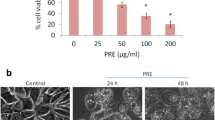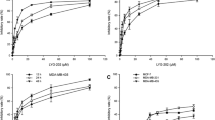Abstract
Chemotherapy represents one of the main conventional therapies for breast cancer. However, tumor cells develop mechanisms to evade chemotherapeutic-induced apoptosis. Thus, it is of great significance to induce non-apoptotic cell death modes, such as paraptosis, in breast cancer. Herein, a novel 8-hydroxyquinoline derivative, 5,7-dibromo-8-(methoxymethoxy)-2-methylquinoline (HQ-11), was obtained and its potential anti-breast cancer mechanisms were investigated. Our results showed that extensive cytoplasmic vacuoles derived from the endoplasmic reticulum (ER) and mitochondria were appeared in MCF7 and MDA-MB-231 breast cancer cells by HQ-11 incubation, and pretreatment of cycloheximide was able to inhibit this vacuolation and HQ-11-induced cell death, showing the characteristics of paraptosis. ER stress was involved in HQ-11-caused paraptosis evidenced by the increase of glucose-regulated protein 78, C/EBP homologous protein and polyubiquitinated proteins. Molecular docking analysis revealed a favorable binding mode of HQ-11 in the active site of the chymotrypsin-like β5 subunit of the proteasome, indicative of proteasome dysfunction under HQ-11 treatment, which might result in further aggravated ER stress. Furthermore, treatment of HQ-11 resulted in increased phosphorylation of extracellular signal-regulated kinase (ERK) and c-Jun NH2-terminal kinase, and inhibition of ERK with U0126 significantly attenuated HQ-11-induced ER stress and paraptosis. In addition, exposure to HQ-11 also caused apoptosis in breast cancer cells partially through activation of ERK pathway. All these results conclusively indicate that HQ-11 triggers two distinct cell death modes via inhibition of proteasome and activation of ERK pathway in breast cancer cells, providing a promising candidate in future anti-breast cancer therapy.







Similar content being viewed by others
Data availability
The datasets used and/or analyzed during the current study are available from the corresponding author on reasonable request.
References
Sung H, Ferlay J, Siegel RL et al (2021) Global cancer statistics 2020: GLOBOCAN estimates of incidence and mortality worldwide for 36 cancers in 185 countries. CA Cancer J Clin 71:209–249. https://doi.org/10.3322/caac.21660
Luque-Bolivar A, Perez-Mora E, Villegas VE et al (2020) Resistance and overcoming resistance in breast cancer. Breast Cancer (Dove Med Press) 12:211–229. https://doi.org/10.2147/BCTT.S270799
Nedeljkovic M, Damjanovic A (2019) Mechanisms of chemotherapy resistance in triple-negative breast cancer-how we can rise to the challenge. Cells 8:957. https://doi.org/10.3390/cells8090957
Lee D, Kim IY, Saha S et al (2016) Paraptosis in the anti-cancer arsenal of natural products. Pharmacol Ther 162:120–133. https://doi.org/10.1016/j.pharmthera.2016.01.003
Fontana F, Raimondi M, Marzagalli M et al (2020) The emerging role of paraptosis in tumor cell biology: perspectives for cancer prevention and therapy with natural compounds. Biochim Biophys Acta Rev Cancer 1873:188338. https://doi.org/10.1016/j.bbcan.2020.188338
Sperandio S, de Belle I, Bredesen DE (2000) An alternative, nonapoptotic form of programmed cell death. Proc Natl Acad Sci U S A 97:14376–14381. https://doi.org/10.1073/pnas.97.26.14376
Sperandio S, Poksay K, de Belle I et al (2004) Paraptosis: mediation by MAP kinases and inhibition by AIP-1/Alix. Cell Death Differ 11:1066–1075. https://doi.org/10.1038/sj.cdd.4401465
Yoon MJ, Kim EH, Lim JH et al (2010) Superoxide anion and proteasomal dysfunction contribute to curcumin-induced paraptosis of malignant breast cancer cells. Free Radic Biol Med 48:713–726. https://doi.org/10.1016/j.freeradbiomed.2009.12.016
Yoon MJ, Lee AR, Jeong SA et al (2014) Release of Ca2+ from the endoplasmic reticulum and its subsequent influx into mitochondria trigger celastrol-induced paraptosis in cancer cells. Oncotarget 5:6816–6831. https://doi.org/10.18632/oncotarget.2256
Ghosh K, De S, Das S et al (2016) Withaferin A induces ROS-mediated paraptosis in human breast cancer cell-lines MCF-7 and MDA-MB-231. PLoS ONE 11:e0168488. https://doi.org/10.1371/journal.pone.0168488
Nguyen PL, Lee CH, Lee H et al (2022) Induction of paraptotic cell death in breast cancer cells by a novel pyrazolo[3,4-h]quinoline derivative through ROS production and endoplasmic reticulum stress. Antioxidants 11:117. https://doi.org/10.3390/antiox11010117
Pyrczak-Felczykowska A, Reekie TA, Jakalski M et al (2022) The isoxazole derivative of usnic acid induces an ER stress response in breast cancer cells that leads to paraptosis-like cell death. Int J Mol Sci 23:1802. https://doi.org/10.3390/ijms23031802
Shiau JY, Nakagawa-Goto K, Lee KH et al (2017) Phytoagent deoxyelephantopin derivative inhibits triple negative breast cancer cell activity by inducing oxidative stress-mediated paraptosis-like cell death. Oncotarget 8:56942–56958. https://doi.org/10.18632/oncotarget.18183
Gupta R, Luxami V, Paul K (2021) Insights of 8-hydroxyquinolines: a novel target in medicinal chemistry. Bioorg Chem 108:104633. https://doi.org/10.1016/j.bioorg.2021.104633
Barilli A, Atzeri C, Bassanetti I et al (2014) Oxidative stress induced by copper and iron complexes with 8-hydroxyquinoline derivatives causes paraptotic death of HeLa cancer cells. Mol Pharm 11:1151–1163. https://doi.org/10.1021/mp400592n
Tardito S, Barilli A, Bassanetti I et al (2012) Copper-dependent cytotoxicity of 8-hydroxyquinoline derivatives correlates with their hydrophobicity and does not require caspase activation. J Med Chem 55:10448–10459. https://doi.org/10.1021/jm301053a
Yuan GZ, Huo YP, Nie XL et al (2012) Structure and photophysical properties of a dimeric Zn(II) complex based on 8-hydroxyquinoline group containing 2,6-dichlorobenzene unit. Tetrahedron 68:8018–8023. https://doi.org/10.1016/j.tet.2012.06.103
Yuan G, Shan W, Liu B et al (2014) Three Mn(II) coordination polymers with a bispyridyl-based quinolinate ligand: the anion-controlled tunable structural and magnetic properties. Dalton Trans 43:9777–9785. https://doi.org/10.1039/c4dt00877d
Yuan G, Hu G, Shan W et al (2015) Structural and luminescence modulation in 8-hydroxyquinolinate-based coordination polymers by varying the dicarboxylic acid. Dalton Trans 44:17774–17783. https://doi.org/10.1039/c5dt02692j
Liu X, Gu Y, Bian Y et al (2021) Honokiol induces paraptosis-like cell death of acute promyelocytic leukemia via mTOR & MAPK signaling pathways activation. Apoptosis 26:195–208. https://doi.org/10.1007/s10495-020-01655-9
Binoy A, Nedungadi D, Katiyar N et al (2019) Plumbagin induces paraptosis in cancer cells by disrupting the sulfhydryl homeostasis and proteasomal function. Chem Biol Interact 310:108733. https://doi.org/10.1016/j.cbi.2019.108733
Ram BM, Ramakrishna G (2014) Endoplasmic reticulum vacuolation and unfolded protein response leading to paraptosis like cell death in cyclosporine A treated cancer cervix cells is mediated by cyclophilin B inhibition. Biochim Biophys Acta 1843:2497–2512. https://doi.org/10.1016/j.bbamcr.2014.06.020
Wang WB, Feng LX, Yue QX et al (2012) Paraptosis accompanied by autophagy and apoptosis was induced by celastrol, a natural compound with influence on proteasome, ER stress and Hsp90. J Cell Physiol 227:2196–2206. https://doi.org/10.1002/jcp.22956
Haynes CM, Titus EA, Cooper AA (2004) Degradation of misfolded proteins prevents ER-derived oxidative stress and cell death. Mol Cell 15:767–776. https://doi.org/10.1016/j.molcel.2004.08.025
Wang S, Guo Y, Yang C et al (2021) Swainsonine triggers paraptosis via ER stress and MAPK signaling pathway in rat primary renal tubular epithelial cells. Front Pharmacol 12:715285. https://doi.org/10.3389/fphar.2021.715285
Sang J, Li W, Diao HJ et al (2021) Jolkinolide B targets thioredoxin and glutathione systems to induce ROS-mediated paraptosis and apoptosis in bladder cancer cells. Cancer Lett 509:13–25. https://doi.org/10.1016/j.canlet.2021.03.030
Fan J, Ren D, Wang J et al (2020) Bruceine D induces lung cancer cell apoptosis and autophagy via the ROS/MAPK signaling pathway in vitro and in vivo. Cell Death Dis 11:126. https://doi.org/10.1038/s41419-020-2317-3
El-Najjar N, Chatila M, Moukadem H et al (2010) Reactive oxygen species mediate thymoquinone-induced apoptosis and activate ERK and JNK signaling. Apoptosis 15:183–195. https://doi.org/10.1007/s10495-009-0421-z
Wang Y, Wen X, Zhang N et al (2019) Small-molecule compounds target paraptosis to improve cancer therapy. Biomed Pharmacother 118:109203. https://doi.org/10.1016/j.biopha.2019.109203
Nedungadi D, Binoy A, Pandurangan N et al (2021) Proteasomal dysfunction and ER stress triggers 2′-hydroxy-retrochalcone-induced paraptosis in cancer cells. Cell Biol Int 45:164–176. https://doi.org/10.1002/cbin.11480
Maria DA, de Souza JG, Morais KL et al (2013) A novel proteasome inhibitor acting in mitochondrial dysfunction, ER stress and ROS production. Invest New Drugs 31:493–505. https://doi.org/10.1007/s10637-012-9871-1
Li X, Wood TE, Sprangers R et al (2010) Effect of noncompetitive proteasome inhibition on bortezomib resistance. J Natl Cancer I 102:1069–1082. https://doi.org/10.1093/jnci/djq198
Chen Q, Song S, Wang Z et al (2021) Isorhamnetin induces the paraptotic cell death through ROS and the ERK/MAPK pathway in OSCC cells. Oral Dis 27:240–250. https://doi.org/10.1111/odi.13548
Yumnam S, Park HS, Kim MK et al (2014) Hesperidin induces paraptosis like cell death in hepatoblastoma, HepG2 Cells: involvement of ERK1/2 MAPK. PLoS ONE 9:e101321. https://doi.org/10.1371/journal.pone.0101321
Fontana F, Moretti RM, Raimondi M et al (2019) δ-Tocotrienol induces apoptosis, involving endoplasmic reticulum stress and autophagy, and paraptosis in prostate cancer cells. Cell Prolif 52:e12576. https://doi.org/10.1111/cpr.12576
Zheng H, Dong Y, Li L et al (2016) Novel benzo[a]quinolizidine analogs induce cancer cell death through paraptosis and apoptosis. J Med Chem 59:5063–5076. https://doi.org/10.1021/acs.jmedchem.6b00484
Wang Y, Zhu X, Yang Z et al (2013) Honokiol induces caspase-independent paraptosis via reactive oxygen species production that is accompanied by apoptosis in leukemia cells. Biochem Biophys Res Commun 430:876–882. https://doi.org/10.1016/j.bbrc.2012.12.063
Li B, Zhao J, Wang CZ et al (2011) Ginsenoside Rh2 induces apoptosis and paraptosis-like cell death in colorectal cancer cells through activation of p53. Cancer Lett 301:185–192. https://doi.org/10.1016/j.canlet.2010.11.015
Funding
This project was supported by National Natural Science Foundation of China (Grant No. 81872449), Anhui Provincial Natural Science Foundation (Grant No. 2008085MH292), the Key Project of Natural Science Research of Universities in Anhui Province (Grant No. KJ2019A0055), and Key Program in the Youth Elite Support Plan in Universities of Anhui Province (Grant Nos. gxyqZD2019020 and gxyqZD2020016).
Author information
Authors and Affiliations
Contributions
LM and ZL conceived and planned the research. LM, XX, MF, YZ and ZL performed the experiment. LM and ZL analyzed the data. GY synthesized the compound HQ-11. LM and ZL wrote the main manuscript. LM, GH and ZL revised the manuscript. All authors read and approved the final manuscript.
Corresponding author
Ethics declarations
Conflict of interest
The authors have no competing interest to declare that are relevant to the content of this article.
Additional information
Publisher’s Note
Springer Nature remains neutral with regard to jurisdictional claims in published maps and institutional affiliations.
Rights and permissions
About this article
Cite this article
Ma, L., Xuan, X., Fan, M. et al. A novel 8-hydroxyquinoline derivative induces breast cancer cell death through paraptosis and apoptosis. Apoptosis 27, 577–589 (2022). https://doi.org/10.1007/s10495-022-01737-w
Accepted:
Published:
Issue Date:
DOI: https://doi.org/10.1007/s10495-022-01737-w




